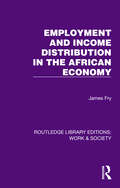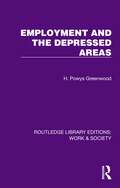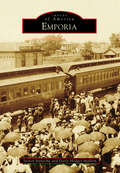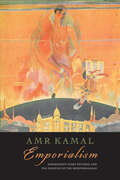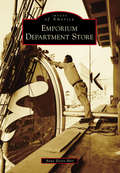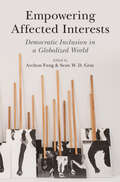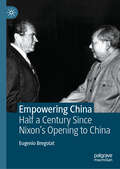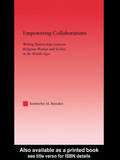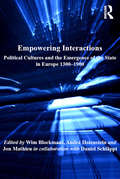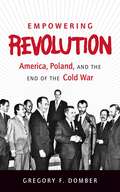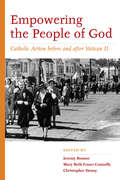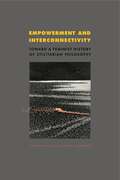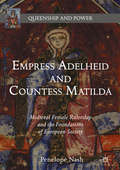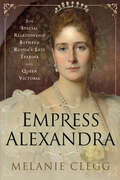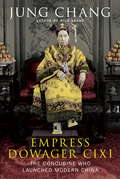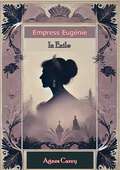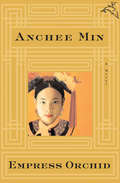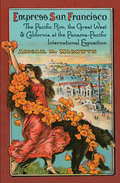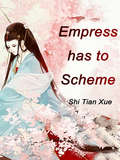- Table View
- List View
Employment and Income Distribution in the African Economy (Routledge Library Editions: Work & Society)
by James FryZambia is one African country which has evolved from being a classic example of a colonial economy to become an independent state with a large export enclave. The economy has had to face structural problems that have at one time or another, characterised other African economies. This study therefore throws light upon many aspects of the labour markets elsewhere in Africa. Originally published in 1979, this book analyses 3 stages of development in the Zambian labour force: the first running up to 1930 when the Copperbelt was opened up, was followed by over 30 years of economic and employment growth, leading to the emergence of a wage and skill structure that differentiated strongly between Africans and non-Africans. Finally there is the period since the early 1960s when the racial basis for employment and earnings restrictions have been lifted but where inequalities remain. Each of these stages is examined in detail and complemented by a theoretical discussion of the factors affecting the development of the wage structure and earnings differentials within Zambia. The impact of government policy income distribution is also discussed and illustrated by means of a comparative study of government income policies in Zambia, Tanzania and Kenya.
Employment and the Depressed Areas (Routledge Library Editions: Work & Society)
by H. Powys GreenwoodOriginally published in 1936 during the Great Depression this book analyses the efforts of the British Government to relieve the rampant unemployment in the most distressed areas and discusses why these efforts were ineffective. The book put forward a number of proposals to help ease unemployment and encourage investment in depressed areas, such as the development of trading estates, investment in transport and social services.
Emporia (Images of America)
by Steven F. Hanschu Darla Hodges MalleinEstablished in February 1857, Emporia's founding fathers named their new business venture Emporia after a flourishing market center in Ancient Carthage. Located in the east-central part of Kansas, Emporia is known as the "Front Porch to the Flint Hills." William Allen White, publisher and editor of the Emporia Gazette, brought national attention to Emporia in the early 1900s. Known for his fiery political essays, White became an advisor to many US presidents, five of whom visited his home, Red Rocks. Emporia is home to Emporia State University, the state's first normal school, founded in 1863. Located on the university campus are the National Teachers Hall of Fame and the Memorial to Fallen Educators, honoring those who lost their lives teaching and working in America's schools. Honoring fallen heroes is a long-standing tradition in Emporia, as it is also the founding city of Veterans Day.
Emporia Rose Appliqué Quilts: New Projects, Historical Vignettes, Classic Designs
by Barbara Brackman Karla Menaugh“Inspired by the still astonishing quilts made from the 1920s through the 1940s in Emporia, Kansas . . . world-renowned for their design and workmanship.” —Publishers Weekly Between 1925 and 1945, women from Emporia, Kansas, created some of the twentieth-century’s most memorable appliqué quilts. Their designs were the modern quilts of their day. They earned both international renown and permanent places in museum collections. Now bestselling quilt historian Barbara Brackman and writer Karla Menaugh bring you seven spectacular new quilts based on those ground-breaking originals, plus the fascinating history of the women and times that produced the Emporia style. Seven projects include a nine-block appliqué sampler, featuring flowers, swags, and festoons.Timeless designs work with any appliqué technique. Mix and match elements into your own new classics.
Emporialism: Department Store Fictions and the Politics of the Mediterranean
by Amr KamalThis book examines what Amr Kamal calls the phenomenon of emporialism, or the convergence between the spaces and imaginaries of empires and emporia in the context of a modern Mediterranean divided among the British, French, and Ottoman empires. By "emporia," Kamal refers to the commercial network of nineteenth-century department stores, which gained prominence after the Suez Canal project. Taking as a focal point French and Egyptian department stores, the author examines emporialism as a set of phenomenological experiences, discursive and social praxes, and mechanisms of control and resistance, born from the intersection of modernity, colonialism, and mass consumption. Drawing on archival evidence, Kamal reads iconographic and literary representations of emporia in English, French, Arabic, and Hebrew, from the nineteenth century to the present, addressing works by Émile Zola, Huda Shaarawi, Jacqueline Kahanoff, and others. Emporialism, Kamal argues, served to rewrite the history of the Mediterranean, to reinvent national belonging, and to interrogate issues of modernity and social justice.
Emporium Department Store
by Anne EversThe Emporium--"California's Largest, America's Grandest Store"--was a major shopping destination on San Francisco's Market Street for a century, from 1896 to 1996. Shoppers flocked to the mid-price store with its beautiful dome and bandstand. Patrons could find anything at the Emporium, from jewelry to stoves, and it was a meeting place for friends to enjoy tea while listening to the Emporium Orchestra. Founded as the Emporium and Golden Rule Bazaar, the store flourished until the disastrous 1906 earthquake. Once it reopened in 1908, it dominated shopping downtown until mid-century. Many San Franciscans remember with great nostalgia the Christmas Carnival on the roof, complete with slides, a skating rink, and a train. Santa always arrived in grand style with a big parade down Market Street. After World War II, the Emporium, which had merged with H.C. Capwell & Co. in the late 1920s, began its push and opened branch stores throughout the San Francisco Bay Area. However, as competition increased, the company's financial situation worsened, and the Emporium name was no more in 1996.
Empowering Affected Interests: Democratic Inclusion in a Globalized World
by Archon Fung Gray, Sean W. D.Many demands for democratic inclusion rest on a simple yet powerful idea. It's a principle of affected interests. The principle states that all those affected by a collective decision should have a say in making that decision. Yet, in today's highly globalized world, the implications of this 'All-Affected Principle' are potentially radical and far-reaching. Empowering Affected Interests brings together a distinguished group of leading democratic theorists and philosophers to debate whether and how to rewrite the rules of democracy to account for the increasing interdependence of states, markets, and peoples. It examines the grounds that justify democratic inclusion across borders of states, localities, and the private sector, on topics ranging from immigration and climate change to labor markets and philanthropy. The result is an original and important reassessment of the All-Affected Principle and its alternatives that advances our understanding of the theory and practice of democracy. This title is also available as Open Access on Cambridge Core.
Empowering China: Half a Century Since Nixon’s Opening to China
by Eugenio BregolatThe author enjoyed the exorbitant privilege of serving three times as Ambassador of Spain to China over a period of 25 years,between 1987 and 2013. He wondered about the US decisive role in empowering China,This book is the result of his review. The book starts with an in-depth analysis of China´s exponential economic development since 1978, adding a reflection on economic power as the crucial underpinning of military and geopolitical might. It underlines that when Nixon first visited China, in February 1972, he and Kissinger already understood that China would become a great power in a few decades and the ensuing risk "to be confronted, if our relations turn sour, with the most formidable enemy that has ever existed". The anticipated risk was taken to achieve short term benefits. Assessing the wisdom of this decision is the thrust of the book. Eight reasons are listed which might have given Nixon and Kissinger second thoughts when they decided to engage China. The contributions of the different US Presidents to the engagement and later containment of China are analyzed. A chapter is devoted to "Unfulfilled prophecies": China and democracy, and the elusive collapse of the Chinese economy. A European epilogue deals with the triangular relationship Europe - US - China. Will Europe be able to reach political union, engineering a renaissance from the ashes of 1945 and becoming again a great power? It is the existential question: to be or not to be. “The book also features a foreword by Javier Solana, former Secretary General of NATO and High Representative for Common Foreign and Security Policy of the European Union.”
Empowering Collaborations: Writing Partnerships between Religious Women and Scribes in the Middle Ages
by Kimberley BenedictThis study examines partnerships between medieval women and scribes. Kimberly Benedict argues that medieval female visionaries often play prominent roles in collaboration while their male amanuenses serves as supports and foils.
Empowering Interactions: Political Cultures and the Emergence of the State in Europe 1300–1900
by Wim Blockmans Daniel SchläppiThe emergence of the state in Europe is a topic that has engaged historians since the establishment of the discipline of history. Yet the primary focus of has nearly always been to take a top-down approach, whereby the formation and consolidation of public institutions is viewed as the outcome of activities by princes and other social elites. Yet, as the essays in this collection show, such an approach does not provide a complete picture. By investigating the importance of local and individual initiatives that contributed to state building from the late middle ages through to the nineteenth century, this volume shows how popular pressure could influence those in power to develop new institutional structures. By not privileging the role of warfare and of elite coercion for state building, it is possible to question the traditional top-down model and explore the degree to which central agencies might have been more important for state representation than for state practice. The studies included in this collection treat many parts of Europe and deal with different phases in the period between the late middle ages and the nineteenth century. Beginning with a critical review of state historiography, the introduction then sets out the concept of 'empowering interactions' which is then explored in the subsequent case studies and a number of historiographical, methodological and theoretical essays. Taken as a whole this collection provides a fascinating platform to reconsider the relationships between top-down and bottom-up processes in the history of the European state.
Empowering Revolution
by Gregory F. DomberAs the most populous country in Eastern Europe as well as the birthplace of the largest anticommunist dissident movement, Poland is crucial in understanding the end of the Cold War. During the 1980s, both the United States and the Soviet Union vied for influence over Poland's politically tumultuous steps toward democratic revolution. In this groundbreaking history, Gregory F. Domber examines American policy toward Poland and its promotion of moderate voices within the opposition, while simultaneously addressing the Soviet and European influences on Poland's revolution in 1989. With a cast including Reagan, Gorbachev, and Pope John Paul II, Domber charts American support of anticommunist opposition groups--particularly Solidarity, the underground movement led by future president Lech Wa&322;&281;sa--and highlights the transnational network of Polish emigres and trade unionists that kept the opposition alive. Utilizing archival research and interviews with Polish and American government officials and opposition leaders, Domber argues that the United States empowered a specific segment of the Polish opposition and illustrates how Soviet leaders unwittingly fostered radical, pro-democratic change through their policies. The result is fresh insight into the global impact of the Polish pro-democracy movement.
Empowering the People of God: Catholic Action before and after Vatican II (Catholic Practice in North America)
by Christopher D. Denny Mary Beth ConnollyThe early 1960s were a heady time for Catholic laypeople. Pope Pius XII’s assurance “You do not belong to the Church. You are the Church” emboldened the laity to challenge Church authority in ways previously considered unthinkable. Empowering the People of God offers a fresh look at the Catholic laity and its relationship with the hierarchy in the period immediately preceding the Second Vatican Council and in the turbulent era that followed. This collection of essays explores a diverse assortment of manifestations of Catholic action, ranging from genteel reform to radical activism, and an equally wide variety of locales, apostolates, and movements.
Empowerment and Interconnectivity: Toward a Feminist History of Utilitarian Philosophy
by Catherine Villanueva GardnerFeminist history of philosophy has successfully focused thus far on canon revision, canon critique, and the recovery of neglected or forgotten women philosophers. However, the methodology remains underexplored, and it seems timely to ask larger questions about how the history of philosophy is to be done and whether there is, or needs to be, a specifically feminist approach to the history of philosophy. In Empowerment and Interconnectivity, Catherine Gardner examines the philosophy of three neglected women philosophers, Catharine Beecher, Frances Wright, and Anna Doyle Wheeler, all of whom were British or American utilitarian philosophers of one stripe or another. Gardner’s focus in this book is less on accounting for the neglect or disappearance of these women philosophers and more on those methodological (or epistemological) questions we need to ask in order to recover their philosophy and categorize it as feminist.
Empowerment and Interconnectivity: Toward a Feminist History of Utilitarian Philosophy
by Catherine Villanueva GardnerFeminist history of philosophy has successfully focused thus far on canon revision, canon critique, and the recovery of neglected or forgotten women philosophers. However, the methodology remains underexplored, and it seems timely to ask larger questions about how the history of philosophy is to be done and whether there is, or needs to be, a specifically feminist approach to the history of philosophy. In Empowerment and Interconnectivity, Catherine Gardner examines the philosophy of three neglected women philosophers, Catharine Beecher, Frances Wright, and Anna Doyle Wheeler, all of whom were British or American utilitarian philosophers of one stripe or another. Gardner’s focus in this book is less on accounting for the neglect or disappearance of these women philosophers and more on those methodological (or epistemological) questions we need to ask in order to recover their philosophy and categorize it as feminist.
Empress Adelheid and Countess Matilda: Medieval Female Rulership and the Foundations of European Society (Queenship and Power)
by Penelope NashThis book compares two successful, elite women, Empress Adelheid (931-999) and Countess Matilda (1046-1115), for their relative ability to retain their wealth and power in the midst of the profound social changes of the eleventh century. The careers of the Ottonian queen and empress Adelheid and Countess Matilda of Tuscany reveal a growth of opportunities for women to access wealth and power. These two women are analyzed under three categories: their relationships with family and friends, how they managed their property (particularly land), and how they ruled. This analysis encourages a better understanding of gender relations in both the past and the present.
Empress Alexandra: The Special Relationship Between Russia's Last Tsarina and Queen Victoria
by Melanie CleggThis intimate look at the bond between Queen Victoria and her granddaughter is “full of details regarding many European royals . . . thoroughly engrossing”(Kathryn J. Atwood, author of Women Heroes of World War II).When Queen Victoria’s second daughter Princess Alice married the Prince Louis of Hesse and Rhine in 1862, even her own mother described the ceremony as “more of a funeral than a wedding,” thanks to the fact that it took place shortly after the death of Alice’s beloved father, Prince Albert. Sadly, the young princess’s misfortunes didn’t end there and when she also died prematurely, her four motherless daughters were taken under the wing of their formidable grandmother, Victoria. Alix, the youngest of Alice’s daughters and allegedly one of the most beautiful princesses in Europe, was a special favorite of the elderly queen, who hoped that she would marry her cousin Prince Albert Victor, Duke of Clarence and one day reign beside him. However, the spirited and stubborn Alix had other ideas…
Empress Dowager Cixii: The Concubine Who Launched Modern China
by Jung ChangFrom the beloved, internationally bestselling author of Wild Swans, and co-author of the bestselling Mao: The Unknown Story, the dramatic, epic biography of the unusual woman who ruled China for 50 years, from concubine to Empress, overturning centuries of traditions and formalities to bring China into the modern world. A woman, an Empress of immense wealth who was largely a prisoner within the compound walls of her palaces, a mother, a ruthless enemy, and a brilliant strategist: Chang makes a compelling case that Cixi was one of the most formidable and enlightened rulers of any nation. Cixi led an intense and singular life. Chosen at the age of 12 to be a concubine by the Emperor Xianfeng, she gave birth to his only male heir who at four was designated Emperor when his father died in 1861. In a brilliant move, the young woman enlisted the help of the Emperor's widow and the two women orchestrated a coup that ousted the regents and made Cixi sole Regent. Untrained and untaught, the two studied history and politics together, ruling the huge nation from behind a curtain. When her boy died, Cixi designated a young nephew as Emperor, continuing her reign till her death in 1908. Chang gives us a complex, riveting portrait of Cixi through a reign as long as that of her fellow Empress, Victoria, whom she longed to meet: her ruthlessness in fighting off rivals; her curiosity to learn; her reliance on Westerners who she placed in key positions; and her sensitivity and desire to preserve the distinctiveness of China's past while overturning traditions (she, as Chang reveals--not Mao, as he claimed--banned footbinding) and exposing its culture to western ideas and technology.
Empress Eugenie in Exile
by Agnes CareyEmpress Eugénie in Exile by Agnes Carey offers a poignant and intimate portrait of Empress Eugénie, the wife of Napoleon III, in the years following the fall of the Second French Empire. Forced into exile after the Franco-Prussian War and the collapse of her husband’s regime in 1870, Eugénie’s life took on new dimensions of personal loss, quiet dignity, and adaptation to changing circumstances. Carey’s work provides a compelling narrative of the empress’s later years, chronicling her life away from the grandeur of the imperial court and the challenges she faced in exile.The book explores Eugénie’s journey from power and influence in France to relative obscurity in England and later Spain, where she sought refuge after the death of her husband and her only son, the Prince Imperial. Through vivid descriptions and well-researched accounts, Carey brings to life the struggles of a woman who had once shaped European politics, fashion, and culture, and who now found herself confronting personal tragedy and navigating a drastically altered world.Carey highlights Eugénie’s enduring grace and resilience as she continued to engage with charitable work, maintain her friendships with European royalty, and reflect on the legacy of the Napoleonic dynasty. The narrative also delves into Eugénie’s involvement in historical events, such as the restoration efforts of the Bonaparte legacy and her ongoing influence in diplomatic and social circles despite her exile.Empress Eugénie in Exile is both a historical biography and a meditation on the themes of loss, identity, and adaptation. It offers readers an insightful look into the life of a woman who, though removed from power, remained a symbol of strength and grace. This book will appeal to those interested in European history, biographies of royalty, and stories of personal perseverance through adversity.
Empress Orchid: A Novel
by Anchee Min&“A fascinating novel, similar to Arthur Golden&’s Memoirs of a Geisha . . . A revisionist portrait of a beautiful and strong-willed woman&” (Houston Chronicle). A San Francisco Chronicle Best Book of the Year From Anchee Min, a master of the historical novel, Empress Orchid sweeps readers into the heart of the Forbidden City to tell the fascinating story of a young concubine who becomes China&’s last empress. Min introduces the beautiful Tzu Hsi, known as Orchid, and weaves an epic of the country girl who seized power through seduction, murder, and endless intrigue. When China is threatened by enemies, she alone seems capable of holding the country together. In this &“absorbing companion piece to her novel Becoming Madame Mao,&” readers and reading groups will once again be transported by Min&’s lavish evocation of the Forbidden City in its last days of imperial glory and by her brilliant portrait of a flawed yet utterly compelling woman who survived, and ultimately dominated, a male world (The New York Times). &“Superb . . . [An] unforgettable heroine.&” —People &“A sexually charged, eye-opening portrayal of the Chinese empire . . . with heart-wrenching scenes of desperate failure and a sensuality that rises off its heated pages.&” —Elle
Empress San Francisco: The Pacific Rim, the Great West, and California at the Panama-Pacific International Exposition
by Abigail M. MarkwynWhen the more than 18 million visitors poured into the Panama-Pacific International Exposition (PPIE) in San Francisco in 1915, they encountered a vision of the world born out of San Francisco’s particular local political and social climate. By seeking to please various constituent groups ranging from the government of Japan to local labor unions and neighborhood associations, fair organizers generated heated debate and conflict about who and what represented San Francisco, California, and the United States at the world’s fair. The PPIE encapsulated the social and political tensions and conflicts of pre–World War I California and presaged the emergence of San Francisco as a cosmopolitan cultural and economic center of the Pacific Rim. Empress San Francisco offers a fresh examination of this, one of the largest and most influential world’s fairs, by considering the local social and political climate of Progressive Era San Francisco. Focusing on the influence exerted by women, Asians and Asian Americans, and working-class labor unions, among others, Abigail M. Markwyn offers a unique analysis both of this world’s fair and the social construction of pre–World War I America and the West.
Empress has to Scheme: Volume 1 (Volume 1 #1)
by Shi TianxueIn the 21st century, because Lin Nan was betrayed by her boyfriend and transported to the Tian Ji Country, she became the daughter of the prime minister. She didn't want to fight, but she had drawn killing intent everywhere … He was the crown prince of the Eastern Palace, the only person who couldn't forget about him despite his heartless nature. He, the unparalleled musician, was unfathomable. Only the melancholy and despair of his back made him feel as if he had met a scum from his past life. Was it an unforgettable relationship, or was it a forsake that was too old for him? Where would she go from here? Where would he return to?
Empress has to Scheme: Volume 2 (Volume 2 #2)
by Shi TianxueIn the 21st century, because Lin Nan was betrayed by her boyfriend and transported to the Tian Ji Country, she became the daughter of the prime minister. She didn't want to fight, but she had drawn killing intent everywhere … He was the crown prince of the Eastern Palace, the only person who couldn't forget about him despite his heartless nature. He, the unparalleled musician, was unfathomable. Only the melancholy and despair of his back made him feel as if he had met a scum from his past life. Was it an unforgettable relationship, or was it a forsake that was too old for him? Where would she go from here? Where would he return to?
Empress has to Scheme: Volume 3 (Volume 3 #3)
by Shi TianxueIn the 21st century, because Lin Nan was betrayed by her boyfriend and transported to the Tian Ji Country, she became the daughter of the prime minister. She didn't want to fight, but she had drawn killing intent everywhere … He was the crown prince of the Eastern Palace, the only person who couldn't forget about him despite his heartless nature. He, the unparalleled musician, was unfathomable. Only the melancholy and despair of his back made him feel as if he had met a scum from his past life. Was it an unforgettable relationship, or was it a forsake that was too old for him? Where would she go from here? Where would he return to?
Empress has to Scheme: Volume 4 (Volume 4 #4)
by Shi TianxueIn the 21st century, because Lin Nan was betrayed by her boyfriend and transported to the Tian Ji Country, she became the daughter of the prime minister. She didn't want to fight, but she had drawn killing intent everywhere … He was the crown prince of the Eastern Palace, the only person who couldn't forget about him despite his heartless nature. He, the unparalleled musician, was unfathomable. Only the melancholy and despair of his back made him feel as if he had met a scum from his past life. Was it an unforgettable relationship, or was it a forsake that was too old for him? Where would she go from here? Where would he return to?
Empress has to Scheme: Volume 5 (Volume 5 #5)
by Shi TianxueIn the 21st century, because Lin Nan was betrayed by her boyfriend and transported to the Tian Ji Country, she became the daughter of the prime minister. She didn't want to fight, but she had drawn killing intent everywhere … He was the crown prince of the Eastern Palace, the only person who couldn't forget about him despite his heartless nature. He, the unparalleled musician, was unfathomable. Only the melancholy and despair of his back made him feel as if he had met a scum from his past life. Was it an unforgettable relationship, or was it a forsake that was too old for him? Where would she go from here? Where would he return to?
